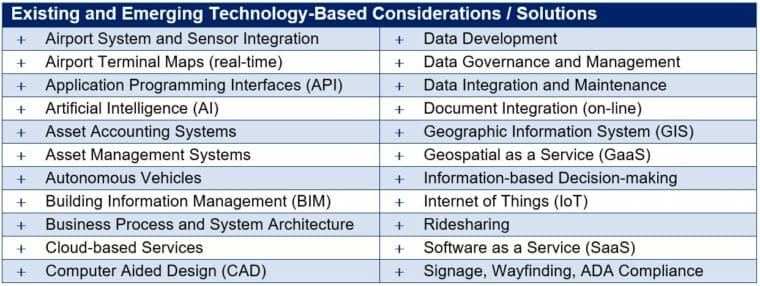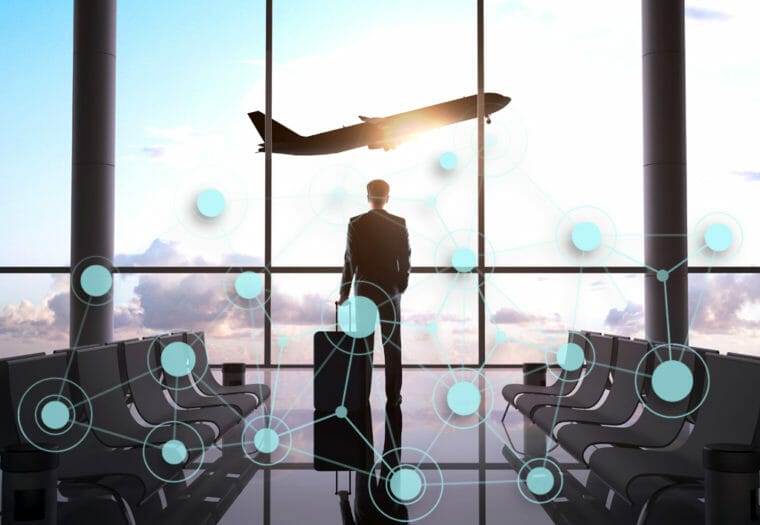Insight | Feb 25, 2019 | Arora
Could Your Digital Foundation Support the Smart Airport of the Future?
By: Gil Neumann
Where are we going? What will it look like when we get there? Is your airport’s information foundation ready for it? Is your digital data scalable and adaptable enough to serve as building blocks for the “smart airport” future?
The Fourth Industrial Revolution
The Fourth Industrial Revolution (Industry 4.0) is characterized as “…the fusion of technologies that are blurring the lines between physical, digital, and biological arenas,” according to World Economic Forum chairman, Klaus Schwab, and international economists.

Schwab posited, “The possibilities of billions of people connected by mobile devices, with unprecedented processing power, storage capacity, and access to knowledge, are unlimited. And these possibilities will be multiplied by emerging technology breakthroughs in fields such as artificial intelligence, robotics, the Internet of Things (IoT), autonomous vehicles, 3-D printing, nanotechnology, biotechnology, materials science, energy storage, and quantum computing.”
In the ever-changing, tech-centric airport operational and management environments, distinctions are fading across strategic planning, design and engineering, and technology disciplines. The future of these domains increasingly relies on understanding how to build bridges to not only harmonize and leverage datasets, but to serve as a standardized platform for improvisation that supports both the strategic aim and tactical decision-making.
Consider the Future
To accommodate emerging technologies that have the same “disruptive” potential of their high-tech counterparts in recent past, airports and communities must distinguish solutions from a nebulous series of hardware and software, technical requirements, developing programs, and regulations and standards, while also effectively navigating the demand of fiscal constraints, complex (and sometimes ambiguous) regulations, and transition challenges.
While many options are promising, which ones provide the foundation for an exceptional customer experience and best serve the airport and community for the future? Decades of lessons learned, and forward-thinking industry research, reveals a variety of existing and emerging technology-based considerations and solutions for airports listed below.

Smart airports know the value of data and digital technology and position them together to enable better, faster decision making and to improve the customer experience. As technology continues to advance, live data is becoming more and more available, which gives governing bodies, financial and infrastructure planners, and data analytics experts the ability to examine events in real-time, to monitor and gain an understanding of patterns and trends, and to respond with thoughtful solutions with the end-user in mind.
For example, real-time sensors are already in use in airport parking structures to show when stalls are occupied or available. Information displays show the number of parking spaces available on parking deck levels—directing drivers to more efficiently accommodate space vacancies and quickly park. This enhances the customer experience, as passengers find themselves in need of quickly parking their vehicle.
So, what can your airport do to ensure its information foundation can meet existing challenges and successfully transform into an agile, provisioned platform that serves potential innovations of the future?
Initiate Collaboration
Whether you are working in a large hub commercial service airport with thousands of employees or a smaller, non-hub airport, interdependencies and information sharing require some measure of proactivity between stakeholders to gather a broad understanding of data needs and available resources (or lack thereof).
The best collaborators:
- Set aside unhelpful assumptions and preconceptions about those with whom they seek to interact.
- Study and prepare before meetings with others.
- Consider the end-user and the return on the investment.
- Find solutions that encompass multi-party interests and that transcend constrained business processes and data silos.
The most successful collaboration efforts include finding forums to share experiences and to learn from stakeholder roles, responsibilities, and missions. Knowledge gathered, and networks built from these interactions, are critical in building partnerships that coalesce around a unified objective and that seek to benefit all stakeholders.
Conduct an Assessment
Some airports are starting their technological transformations with inherent advantages, such as a technical infrastructure already built on solid development principles and data gathered with well-defined standards. Some airports or authorities in these scenarios have often already ventured into the foray of large-scale asset management, while others have partially-built technological foundations and/or stale datasets that no longer serve the purpose for which they were built or gathered.
Whether it is an examination of large-scale asset management systems or of disparate datasets across multiple airport or government departments, a good place to start is with an assessment of available resources and existing information. An assessment provides context to identify a starting point, before casting a vision and building a strategy that defines and prioritizes the steps that must be taken to meet future technology and data needs.
Build a Roadmap
It is easy for airport decision-makers to feel helpless or to choose the path of least resistance in the face of these incremental, transitional, and tectonic shifts. Can the promise of long-term effectiveness, efficiency, or cost savings be achieved? The answer to this question is most certainly no, if struggles persist through uncoordinated visions, resistance to change, or incongruent planning of data development and implementation.
Airports would do well to consider building a strategic vision that prioritizes the need to coordinate available technologies which connect to numerous technology-based solutions. For example, the increased use of ridesharing in cities and at airports propels the need for better signage and wayfinding. The passenger experience is enhanced with better terminal maps and Wi-Fi signals that connect to their smart phones and provide useful information to the end-user. Similarly, aircraft are using satellite-based navigation to fly along prescribed air traffic routes designed from aeronautical survey data. Each of these solutions (and many more) require accurate location-based data collection and a supporting technical construct.
Leverage Requirements
Broad governance, regulations, and financial considerations at all levels of government, as well as the specific function and economic impact of an airport, create a complex environment for building a technology foundation. There are numerous statutory requirements and government programs designed with the intention of promoting airport safety and efficiency.

Many of these requirements provide the impetus, and more importantly the funding, to build initial infrastructure foundations for technology and data. Airports and government agencies across the country have numerous datasets, spanning different departments, that were built or gathered from government data requirements. Without a strategy to leverage opportunity, these efforts run the risk of being incomplete, incongruent, or simply a snapshot in time. Indeed, if technology and data investments were employed to satisfy the requirements for one specific project, the risk of these resources growing stale is heightened without a broader vision and implementation plan in play.
Thus, airports must leverage existing requirements to not only build technology and datasets, but also to ensure there is a return on the long-term investment. Some of these requirements can be directly supported by using available technologies and applications. However, technology execution and implementation—particularly in government-run organizations—must be leveraged as an asset or a commodity of sorts.
The Future is Coming
Airports and local communities recognize that technology is important, and that information and data analyses have tremendous value. Most organizations have a variety of datasets ranging in levels of maturity, congruency, and interdependency. Large airports with departmental or data silos, and small airports with limited resources, need help collecting and maintaining data, as well as using the data as a return on their investment. Users want helpful, user-friendly applications; management wants a return on their investment; IT wants security, stability, performance, and scalability; and airports, in general, want to better collaborate with government organizations and to provide accurate, timely, and thoughtful information. Is your airport ready?
Understanding your technology base is critical to preparing for the smart airports of the future. A deficient technology foundation makes it almost impossible to build second and third layers of specific applications that pull raw data and translate the information into potential insight for solutions or stakeholder alerts that point to actions. So, what are you doing today to prepare your airport for the future?



